Inflatable Wing Foil Boards
Inflatable boards have earned their place in windsurfing and stand-up paddling. So it is no surprise that inflatable wing-foil boards have also become popular.
Wing foiling is developing so fast that it’s hard to keep track of all the newest innovations. In this article we bring you up to speed, so that you’re able to choose which inflatable board suits you best.
Inflatable boards versus hard boards
Inflatable boards have some clear advantages over hard boards:
- Durability. Any hard board that is well-used is almost guaranteed to pick up some dings or cracks, for example from your harness hook or local slipway. An inflatable board is basically immune to this sort of wear and tear damage.
- Small package. You can carry the board inside a backpack wherever you like. And it doesn’t take up much storage space.
- Price. There is a wide price range for inflatable boards. At the entry price point there are proper inflatable boards for half the price of hard boards.
But there are also some disadvantages...
- Stiffness. Although the stiffness of inflatable boards has been much improved by some smart innovations (we’ll discuss these later), hard boards still have a much more direct feel.
- Water release. On a hard board, the shaper can use channels and rails to improve the water release. On an inflatable board there is much less geometric freedom. So an inflatable board will be a little harder to lift off.
- Weight. Inflatable boards are usually a bit heavier than hard boards. This makes them less suitable for jumping.
Note that wing foiling boards spend most of their time above the water. This means that in wing foiling the disadvantages of inflatable construction are much less significant than in a sport like windsurfing where the board is always in the water. It also means that even for experienced wing foilers an inflatable board can be a suitable choice.
Board measurements
In general, a bigger board is more stable on the water but is also heavier, while a small board is more responsive to pumping and more agile. But there’s more to consider:
Volume: This is the most important measurement. As a beginner, the biggest challenge is standing up on your board and then getting the board to lift off on the foil. All this becomes much easier if your board provides lots of stability and buoyancy. When you progress you probably want your board to be lighter and more responsive, so when riders become more advanced they usually change their board for a smaller one.
It is important to realise that the volume of a hard board does not directly translate to the volume of an inflatable board. Due to their rounded shape, inflatables lie less stable on the water than a hard board of the same volume. For equivalent stability, you should choose an inflatable board to be about 1.3 to 1.5 times the volume of a hard board.
Large riders require a bigger board than small riders. A rough rule of thumb:
- Beginner, 60 kg: hard board 90-100 L, inflatable board 130-150 L
- Beginner, 80 kg: hard board 110-120 L, inflatable board 160-180 L
Length: A longer board will lift off more smoothly. But it is very hard to pump a longer board and the nose is more inclined to contact the surface when the water is choppy. For these reasons most wing foil boards are short.
Width: A wider board lies more stable on the water, which is good for beginners.
Board construction
The construction of a board influences its stiffness, weight and durability. Stiffness is very important, as a rigid board has much less drag than a board that bends under the load of the surfer.
All inflatable boards are made with “dropstitch” PVC. This material is made of 2 layers of fibre-reinforced PVC that are connected by vertical threads (see below image). The length of these threads determines the thickness of the board. Because all the threads have the same length, the top and bottom of inflatable boards are flat – without contours. The scoop and/or rocker of the board is achieved by shaping of the sidewalls, and by making the top layer a bit shorter than the bottom layer.
There are 3 main dropstitch techniques:
- Single layer (SL). Simple and budget-friendly. Best suited for boards that will receive light recreational use.
- Double layer. The board has an extra layer of fibre-reinforced PVC laminate. Heavier than single layer, but much stiffer and much more durable.
- Fusion Composite Dropstitch (FCD). The best available. More fibres, less PVC and less glue than the double layer construction. This makes the boards lighter, stiffer and very durable.
All Unifiber iFoil boards use FCD construction to provide a reliable and responsive ride.
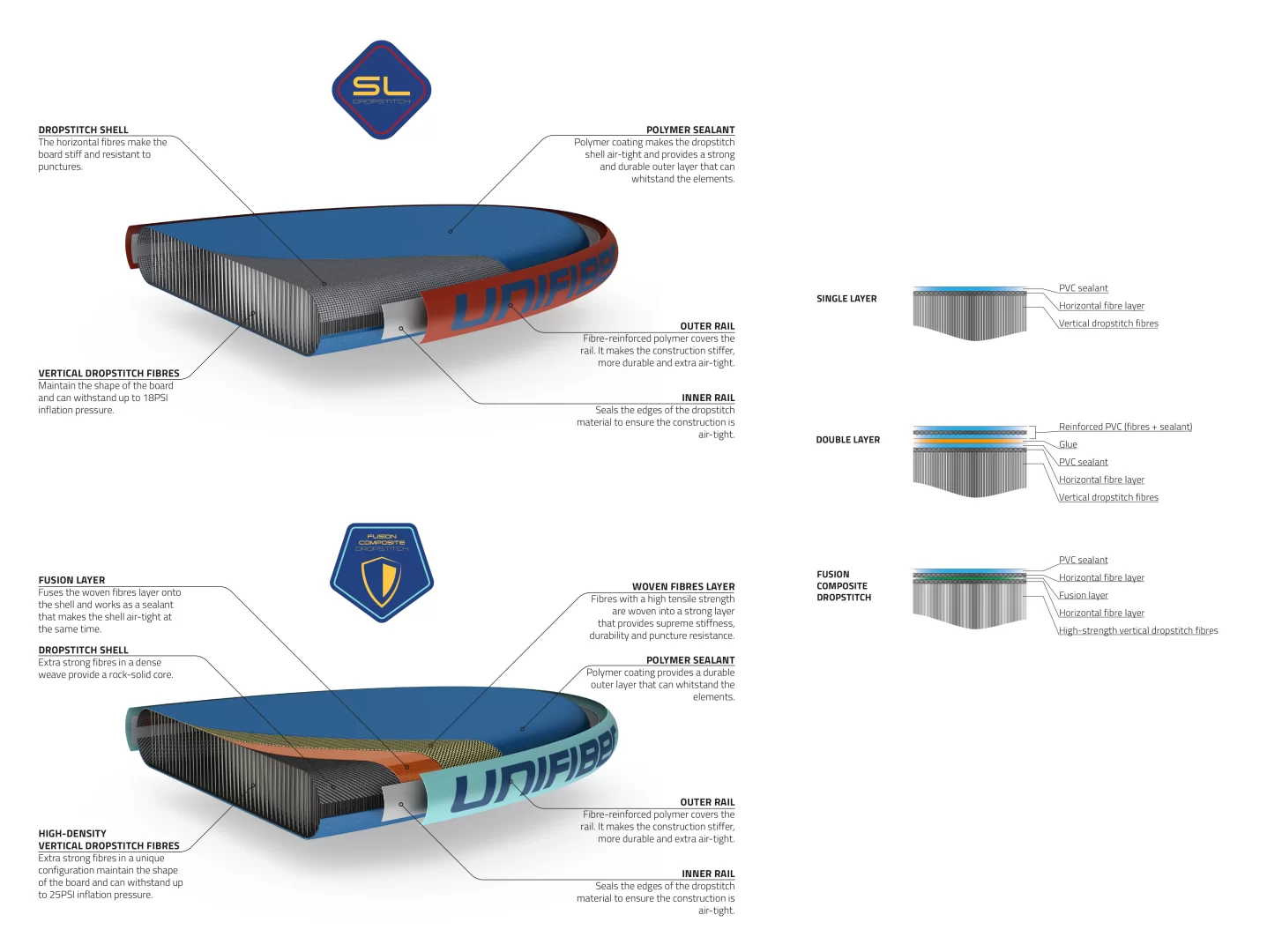
Price vs quality
A higher price doesn’t necessarily make a board better. However, there are a lot of cheap inflatable boards on the market with poor build quality and sub-standard quality control. A badly built board can lead to life-threatening situations, so be wise when buying an inflatable board. We advise that you buy from a shop that specialises in watersports. They can help you find a suitable and reliable board that also represents good value.
Board-to-foil connection
When you’re gliding above the water, the board is not much more than the connector between you and the foil. How the foil is connected to the board is therefore one of the most important features of a wing foil board.
Almost all wing foils use a plate adapter to connect to the board. The most commonly used methods of connecting it to the board are:
- 4 screw inserts. This is the most basic method. All stiffness is provided by the inflatable board itself, so there is a lot of unwanted flex. This really spoils the riding experience. And since it doesn’t distribute the forces very well, the system is more prone to failure. It is light, cheap and compact, though.
- Composite double-slotted plate. The plate is made of a combination of glass fibre and carbon fibre. It is glued under the board and it distributes the forces over a large surface. It is strong, and provides stiffness and responsiveness that approach that of a hard board. The slots allow you to fine-tune the lift of the foil. The downside is that it makes the folded-up package relatively big.
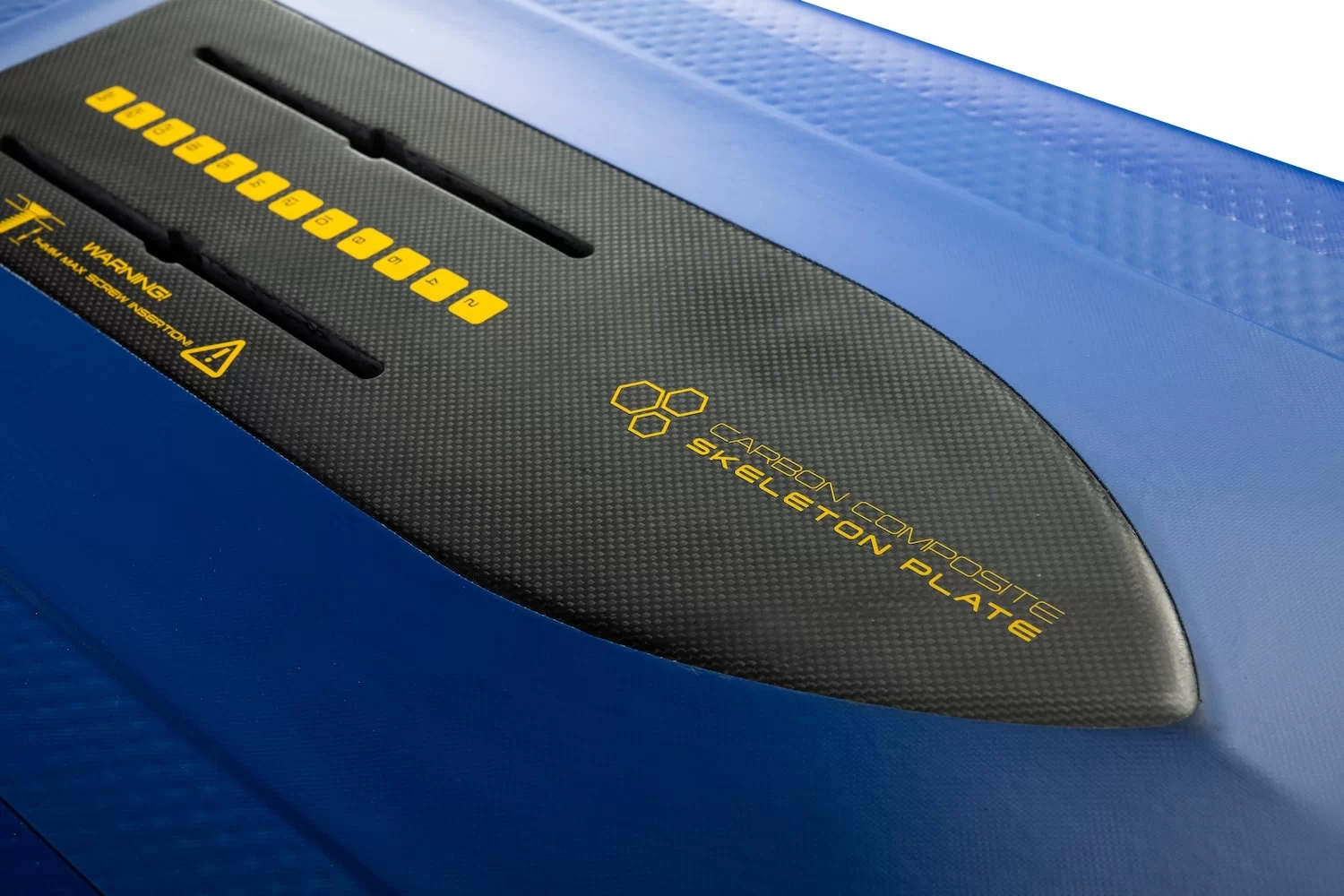
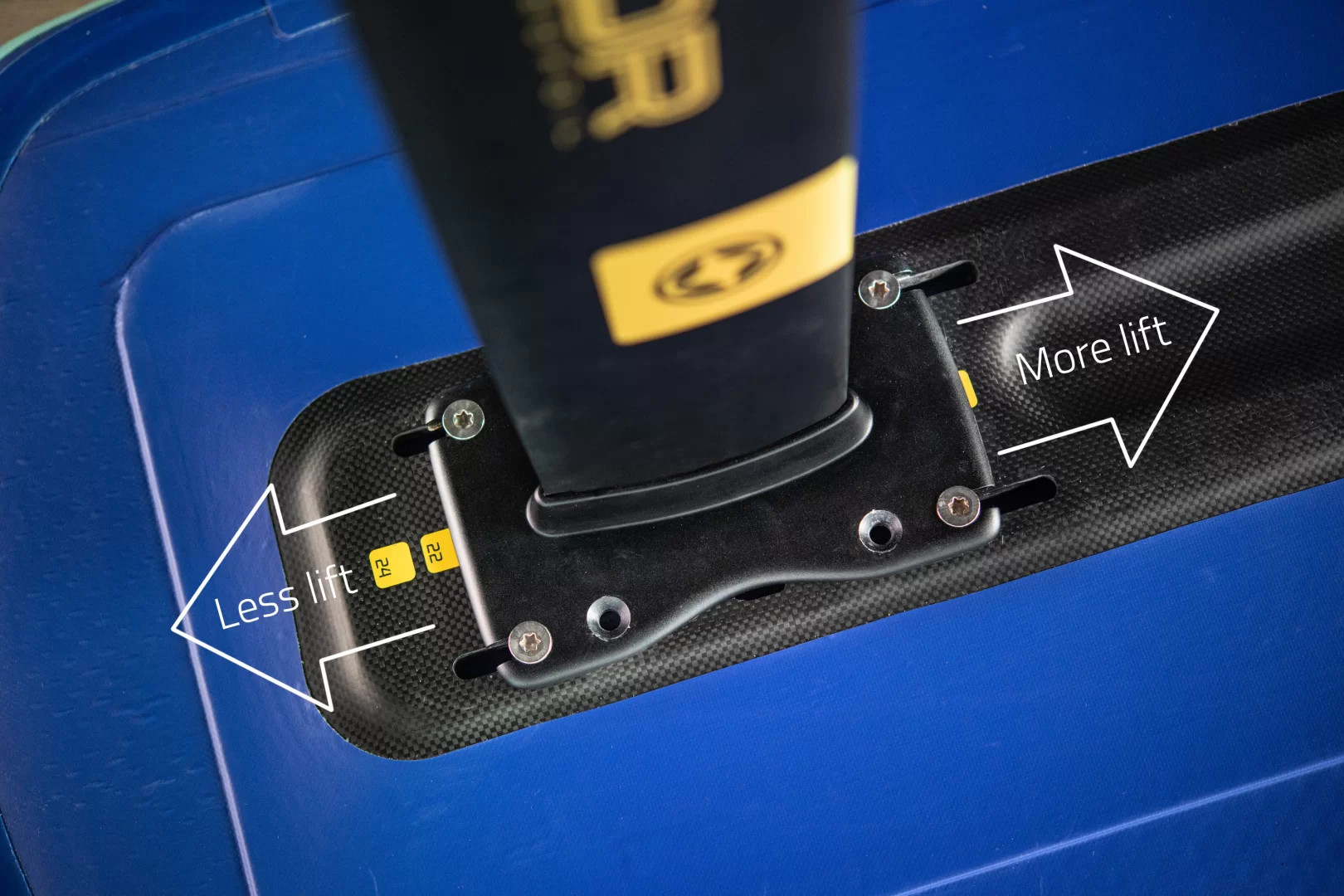
- Bottom-to-deck insert. A hard block that has the same slots as the above-mentioned plate, but instead of spreading the forces over the bottom of the board, it connects to both the bottom and the deck. It provides quite a stiff connection, but is not as stiff as the composite plate system.
Footstraps
This is a matter of personal preference. Some beginner riders like footstraps, because they help to automatically have your feet in the ideal position on the board. Advanced riders may enjoy the responsiveness of being strapped to their board. But footstraps may also limit your movement, which you might need to compensate for small mistakes or for fine tuning of board trim.
From what we have observed lots of riders prefer to ride without footstraps al all while some keep the front footstrap only. They use a free rear foot to control the lift of the foil, while the front foot is well attached on the board and provides greater control when pumping and in turns. Maybe that is best of both worlds? But be careful, because a wipe-out with only one foot attached to the board can more easily result in injury.
Obviously, when you want to jump you need both your feet in the straps. Otherwise, you’re in for a swim.
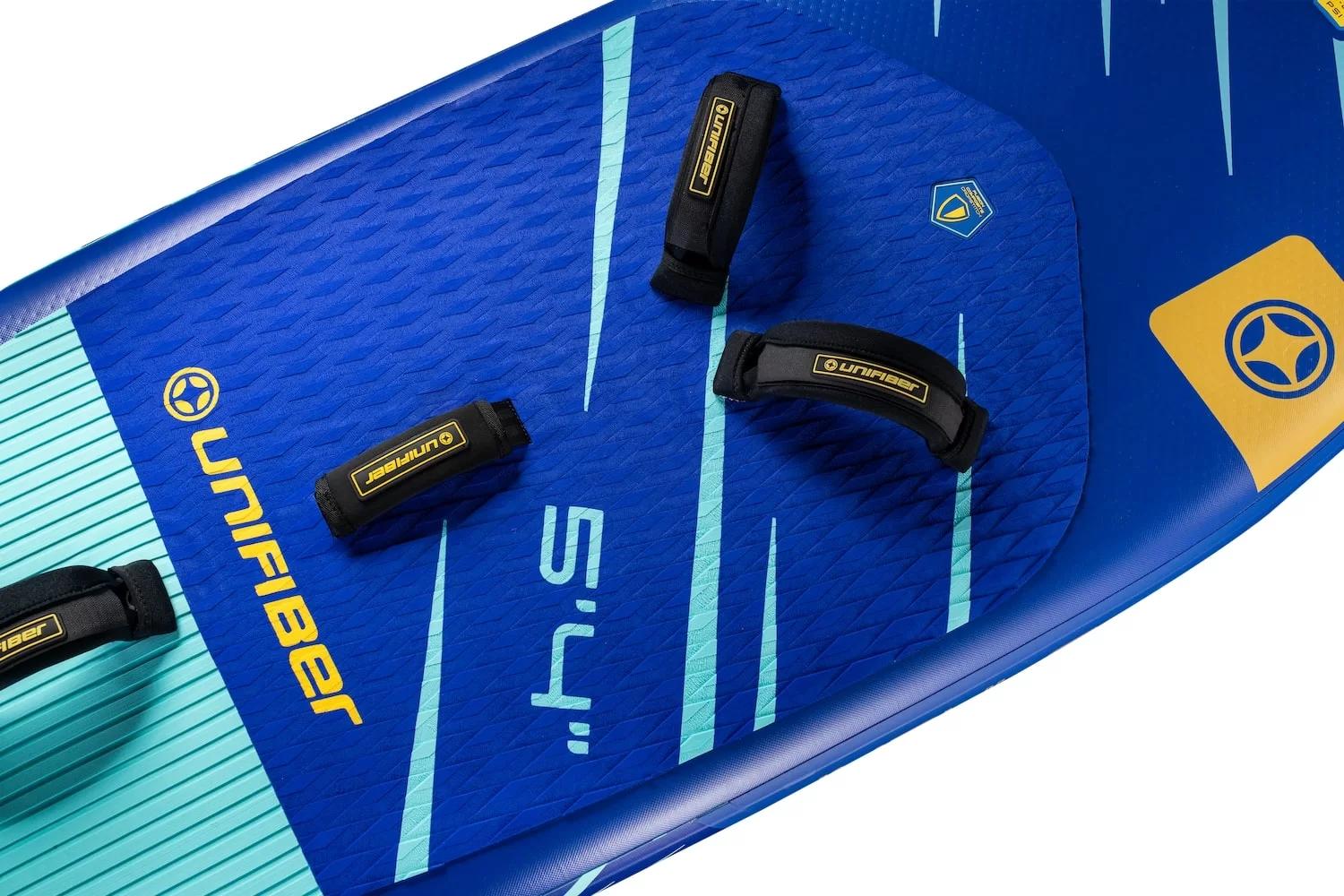
PVC rail
This feature has been adopted from inflatable windsurf boards. It improves water release thereby making it easier to lift off. For experienced riders who use small boards (and pump to get them out of the water) a PVC rail provides minimal benefit.
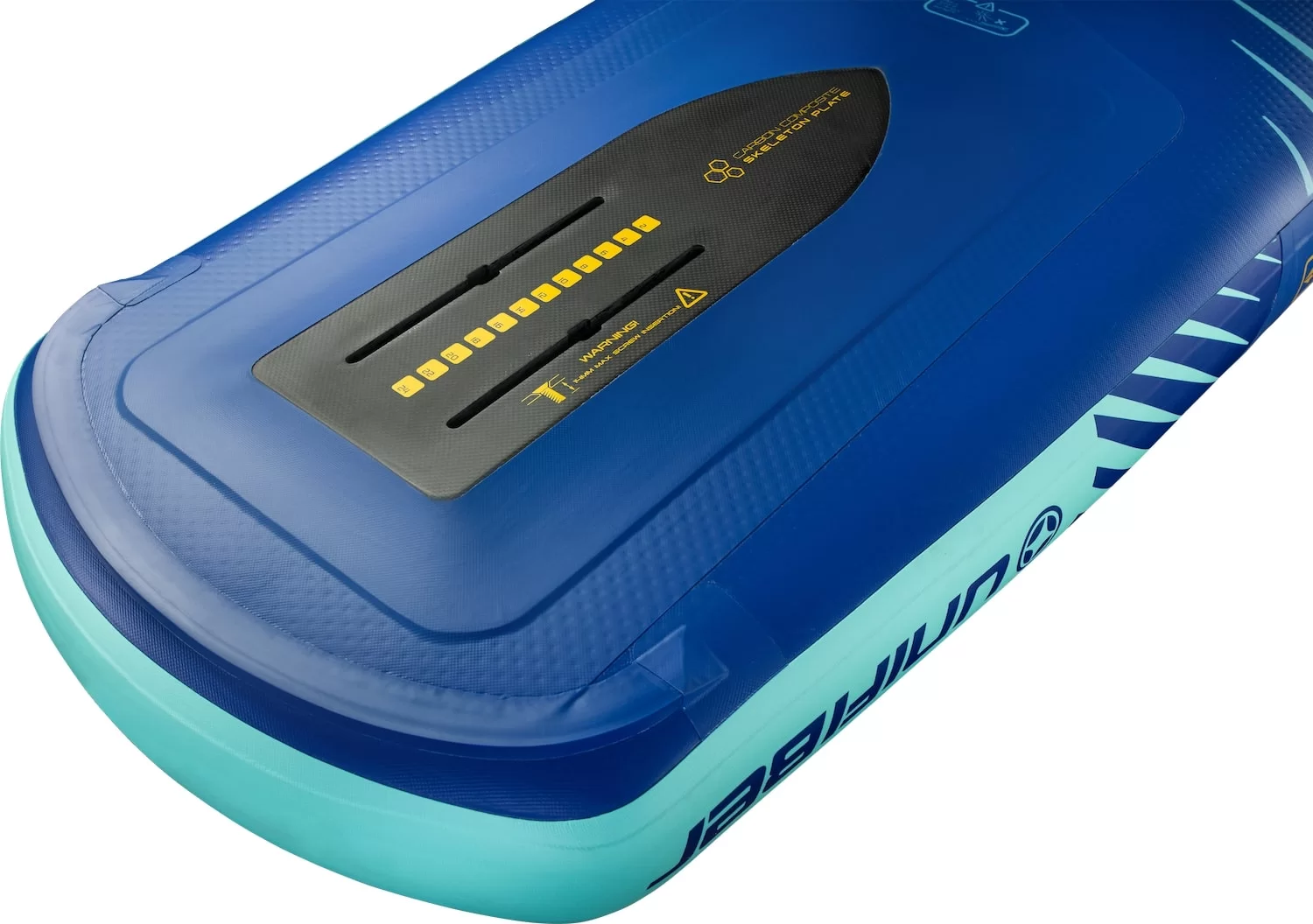
Why Choose Unifiber iFoil boards?
Unifiber strives to offer a versatile and budget-friendly alternative to hard construction wing foil boards. The result – our iFoil range – combines fun, exciting, accessible wing foiling with a package that is compact and easy to carry around.
We maintain an extremely high standard of quality control. In addition to numerous checkpoints during manufacturing we do a final 72-hour test to check for any possible leakage. For every single board.
Fusion Composite Dropstitch technology is used in our boards to provide top-rated strength and stiffness, and minimal weight.
Unifiber also offers a comprehensive 1-year unconditional warranty on all iWindsurf models and 2-years coverage for manufacturing faults.